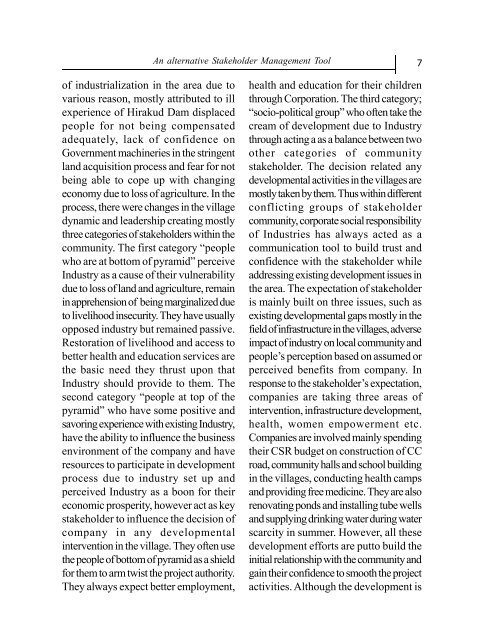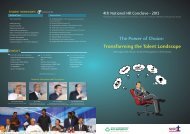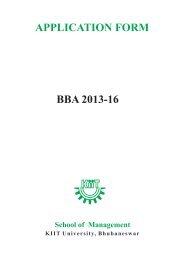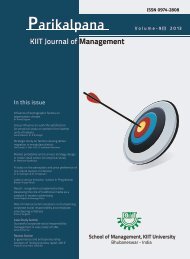Download - School of Management, KIIT University
Download - School of Management, KIIT University
Download - School of Management, KIIT University
Create successful ePaper yourself
Turn your PDF publications into a flip-book with our unique Google optimized e-Paper software.
An alternative Stakeholder <strong>Management</strong> Tool<br />
7<br />
<strong>of</strong> industrialization in the area due to<br />
various reason, mostly attributed to ill<br />
experience <strong>of</strong> Hirakud Dam displaced<br />
people for not being compensated<br />
adequately, lack <strong>of</strong> confidence on<br />
Government machineries in the stringent<br />
land acquisition process and fear for not<br />
being able to cope up with changing<br />
economy due to loss <strong>of</strong> agriculture. In the<br />
process, there were changes in the village<br />
dynamic and leadership creating mostly<br />
three categories <strong>of</strong> stakeholders within the<br />
community. The first category “people<br />
who are at bottom <strong>of</strong> pyramid” perceive<br />
Industry as a cause <strong>of</strong> their vulnerability<br />
due to loss <strong>of</strong> land and agriculture, remain<br />
in apprehension <strong>of</strong> being marginalized due<br />
to livelihood insecurity. They have usually<br />
opposed industry but remained passive.<br />
Restoration <strong>of</strong> livelihood and access to<br />
better health and education services are<br />
the basic need they thrust upon that<br />
Industry should provide to them. The<br />
second category “people at top <strong>of</strong> the<br />
pyramid” who have some positive and<br />
savoring experience with existing Industry,<br />
have the ability to influence the business<br />
environment <strong>of</strong> the company and have<br />
resources to participate in development<br />
process due to industry set up and<br />
perceived Industry as a boon for their<br />
economic prosperity, however act as key<br />
stakeholder to influence the decision <strong>of</strong><br />
company in any developmental<br />
intervention in the village. They <strong>of</strong>ten use<br />
the people <strong>of</strong> bottom <strong>of</strong> pyramid as a shield<br />
for them to arm twist the project authority.<br />
They always expect better employment,<br />
health and education for their children<br />
through Corporation. The third category;<br />
“socio-political group” who <strong>of</strong>ten take the<br />
cream <strong>of</strong> development due to Industry<br />
through acting a as a balance between two<br />
other categories <strong>of</strong> community<br />
stakeholder. The decision related any<br />
developmental activities in the villages are<br />
mostly taken by them. Thus within different<br />
conflicting groups <strong>of</strong> stakeholder<br />
community, corporate social responsibility<br />
<strong>of</strong> Industries has always acted as a<br />
communication tool to build trust and<br />
confidence with the stakeholder while<br />
addressing existing development issues in<br />
the area. The expectation <strong>of</strong> stakeholder<br />
is mainly built on three issues, such as<br />
existing developmental gaps mostly in the<br />
field <strong>of</strong> infrastructure in the villages, adverse<br />
impact <strong>of</strong> industry on local community and<br />
people’s perception based on assumed or<br />
perceived benefits from company. In<br />
response to the stakeholder’s expectation,<br />
companies are taking three areas <strong>of</strong><br />
intervention, infrastructure development,<br />
health, women empowerment etc.<br />
Companies are involved mainly spending<br />
their CSR budget on construction <strong>of</strong> CC<br />
road, community halls and school building<br />
in the villages, conducting health camps<br />
and providing free medicine. They are also<br />
renovating ponds and installing tube wells<br />
and supplying drinking water during water<br />
scarcity in summer. However, all these<br />
development efforts are putto build the<br />
initial relationship with the community and<br />
gain their confidence to smooth the project<br />
activities. Although the development is







